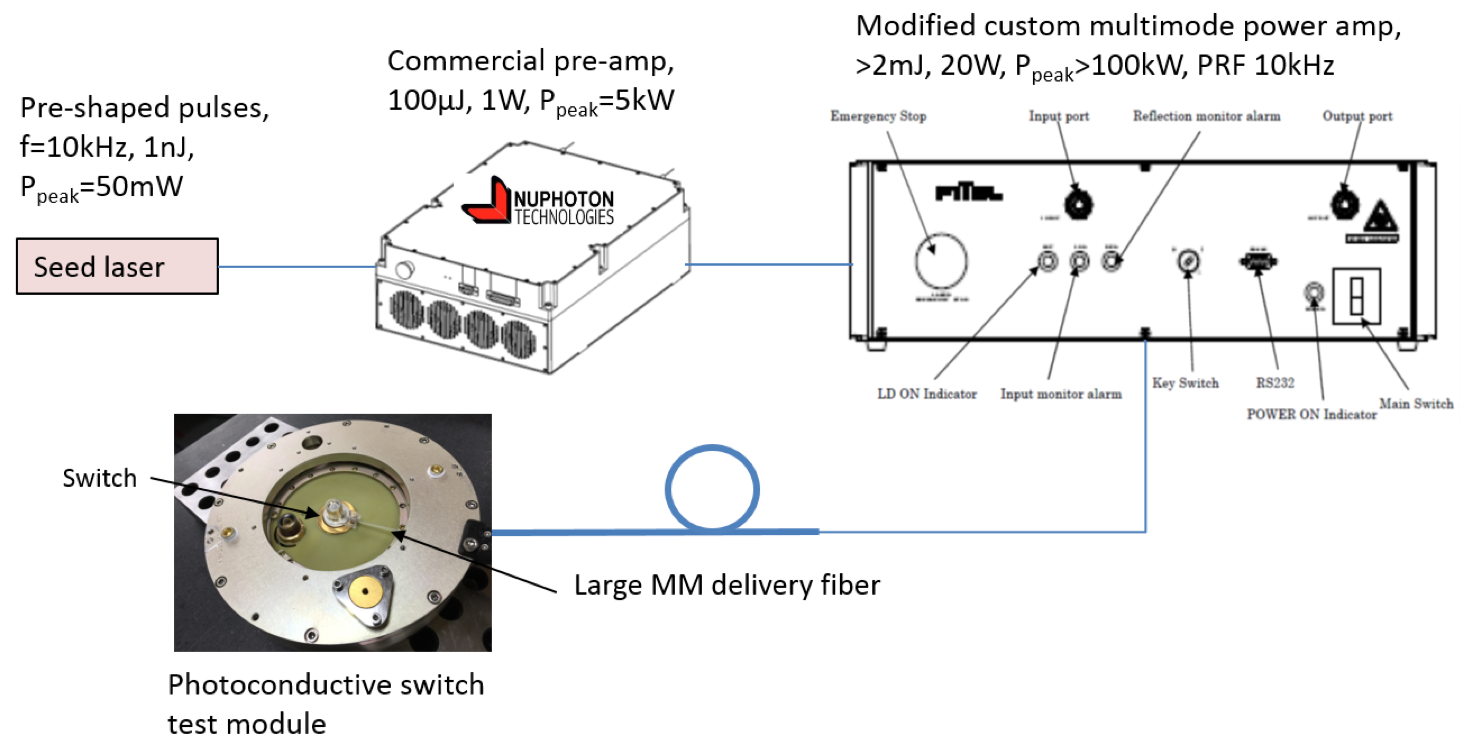Adam Conway (17-ERD-105)
Executive Summary
We are exploring a novel all-fiber laser with innovative switches to reduce the size, weight, and power requirements by 250 times while improving the bandwidth and pulse repetition, thus enabling a compact design for use in the field. Applications include electronic countermeasures, neutralizing improvised explosive devices, and countering unmanned aerial systems.
Project Description
High-power, radio-frequency directed energy is a vital component of the next generation of warfare systems for the U.S. military. This directed-energy technology is based on an intense pulse of radio waves that can upset, disrupt, or destroy electronic devices and systems. It offers a number of advantages over conventional kinetic munitions, including minimized collateral damage, all-weather operation, “speed-of-light” engagement, a deep magazine, and non-line-of-sight effects that enable covert actions. However, the attack is typically indiscriminate within the beam angle of 5 to 10°. In addition, the battle damage is not always easy to assess and the intensity of the electric field decreases rapidly with range. Existing vacuum-tube technologies, while capable of generating high peak radio-frequency power, have deficiencies in that they do not posses frequency flexibility or waveform agility. In addition, these vacuum-tube technologies have low power density and thus large size, weight, and power requirements. Lawrence Livermore National Laboratory has demonstrated a frequency-flexible, semiconductor-based, radio-frequency power-generation technology using silicon carbide photoconductive switches driven by a modulated solid-state laser. However, the large size of the laser relative to the size of the switch limits its adoption. We are exploring a novel 200-kW all-fiber laser with innovative switches to reduce the size, weight, and power required by 250 times, while improving the radio-frequency bandwidth by four times and pulse repetition frequency by 100 times, as well as enabling a compact design for enhanced fielding capability. Our highly efficient, scalable, and reliable laser design is based on fiber laser technology developed at the Laboratory. When combined with ongoing efforts to improve photon-to-electron conversion efficiency, our design will reduce the total system size from that of a tractor-trailer to a Humvee.
There are several key research issues that must be addressed before the technology of high-power radio-frequency systems can be considered feasible for deployment in real-world applications: the inefficient generation of photons in the laser system, its relative lack of ruggedness, and low conversion efficiency of photons to electrons in the photoconductive switch. Recently, the Laboratory demonstrated the feasibility of semiconductor-based, megawatt-class, radio-frequency power generation using wide-bandgap silicon carbide photoconductive semiconductor switches driven by a modulated solid-state laser, which is scalable to gigawatt class on a motor vehicle. The heart of the technology is vanadium-doped silicon carbide, a unique material that enables exceptional standoff voltages (>30 kV), high currents (>400 A), linear response, rapid on/off switching (<50 ps), and a wide range of frequencies (direct current to gigahertz). While adequate for laboratory demonstrations, this system is inherently inefficient and lacks the ruggedness required for military deployment. We expect to accelerate the development of a novel, high-power, radio-frequency technology by demonstrating for the first time a frequency-flexible, compact, rugged, and reliable 200-kW all-fiber laser driving an efficient total-internal-reflection, linear photoconductive switch module. Using this technology, we will create a prototype of the next-generation high-power, radio-frequency directed-energy system. The photoconductive switch is a multi-pass optical cavity, with light reflecting off the walls until it is absorbed in the semiconductor volume or at interfaces. By implementing an all-fiber-based laser system (which increases the laser efficiency by five times) and combining it with the total-internal-reflection, linear photoconductive switch design (which reduces the laser power requirement by 50 times), the overall system size will be reduced by 250 times while maintaining the required features of frequency flexibility and waveform agility in a system that is inherently rugged and reliable.
Mission Relevance
Our technology is intended for use as a radio-frequency or microwave directed-energy source, with broad applications in defense and homeland security spanning electronic countermeasures, neutralization of improvised explosive devices, and countering of unmanned aerial systems. Additionally, it has the potential for use in high radio-frequency power generation at significantly reduced system size and weight, as well as increased power output. This could enable new applications in support of the Laboratory’s directed-energy mission research challenge, and supports the NNSA goal to expand and apply our science and technology capabilities to deal with broader national security challenges. In addition, the technology has applications for novel compact laser designs in support of the Laboratory’s core competency in lasers and optical science and technology.
FY17 Accomplishments and Results
Our main accomplishments for FY17 were in laser design and procurement. Specifically, we (1) determined requirements for specific components and parts, simulated performance, and increased our system's repetition-rate design point from 10 to 100 kHz to enable the activities planned for FY18; (2) leveraged existing hardware for the front end of the laser system, including an arbitrary waveform generator, a continuous-wave fiber laser, and acousto-optic and electro-optic modulators to encode the pulse train onto the continuous-wave source; and (3) procured the laser components and assembled and tested the prototype system.
   






